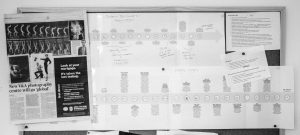
Photography is sewn firmly into the fabric of power. For proof of this, you need only consider three recent images: Nilüfer Demir’s photograph of Alan Kurdi; Jonathan Bachman’s photograph of Baton Rouge protester Ieshia Evans; and Jeff Mitchell’s shot of refugees queueing at the Slovenia-Croatia border (the logic of which was notoriously inverted by UKIP). These photographs are not just intrinsically powerful. In each instance, their existence has directly conditioned the ever-shifting dynamics of real-world power.
As I write this, I’m flicking through Pam Roberts’ compendium of the Royal Photographic Society Collection from 2000. Page 69 features Don McCullin’s portrait of a mother and child fleeing civil war in East Pakistan (1971). On page 107, a four year old Prince Arthur (third son of Victoria and Albert) is dressed in full military attire, in an Albumen print made by Roger Fenton (1854). And on page 229, there’s an early example of pornography: an anonymous, hand coloured stereo daguerreotype (c.1855).
Taken together, these photos have a combined age of 371 years. But they remain eerily germane to power dynamics that still shape the present moment: war, displacement, celebrity, sexual objectification. And you might even say that at certain points in history, each of these photos played their own particular roles in conditioning or perpetuating such dynamics.
In the compendium, Roberts writes that the invention of photography:
‘…redefined previous perceptions of space and time and created a new vision with which to see the world, a third eye.’
I would go one further and say that this ‘third eye’ opened up to the human experience an entirely new power-play. And I would argue that the RPS Collection – a vast, 200-year inventory of several hundred corresponding photo archives – is as much a record of power as it is of anything else.
This is why I was initially drawn to the story of the Collection’s centralising transfer from Bradford to South Kensington. I was interested in the administrative history of the Collection itself because it’s such a strange and almost paradoxical history. The archives emerged out of late-19th century, high society London; then, at the start of the 21st century, they were brought under public ownership and democratised by a fledgeling regional museum. And this year they were transferred back into a high-culture setting befitting of their roots – the hallowed backrooms of the V&A.
The key justification for this move is that the V&A will enhance ease of access to the Collection for academics and the general public. Only about two percent of the Collection was digitised before the move, and physical access in Bradford was by limited appointment only. To its credit, the V&A has already opened up access to the archives at the point of physical use (even walk-in requests can be accommodated) and it is steadily digitising the entire catalogue in real time (a huge and invaluable undertaking). But this only tells half the story.
In Drawn by Light (my documentary on the transfer), I explore the access justification in detail, and show how it actually masks wider issues at play. For one thing, the justification is perversely underpinned by a stark disparity of curatorial resources between the V&A and the museum in Bradford (recently rebranded the National Science and Media Museum). For another, the justification ignores quite how centralised access to cultural assets has become in the UK.
And this all reflects a big problem with cultural funding across the country: namely, that the bulk of both public and private sponsorship is narrowly trained on distinct pockets of inner London. Access in the arts has never been a straightforward thing, and improved access at the point of use is no guarantor of more democratic access nationally.
Beyond tackling some of the institutional rhetoric that accompanied the transfer, the documentary also sheds light on the underlying forces that shaped events. The quirks of centralised trustee governance are laid bare when the documentary asks why there was no consultation on the transfer in the first place. And I also explore how institutional decision-making was coloured by the centralising pull of austerity.
But in a sense, the documentary should ultimately stand as an appraisal of how we lost a national museum for photography. The southbound transfer of the RPS collection marks the spiritual endpoint of such an institution. Only last month, Martin Parr publicly bemoaned the under appreciation of photography by the British art world, and indeed by the British state. Established institutions like the V&A are only belatedly getting wise to the power and worth of photography. I suppose it should come as no surprise that the archives of the RPS Collection have now been ushered back into the traditional annals of cultural power.
You can listen to Drawn by Light at www.drawnbylightpodcast.org